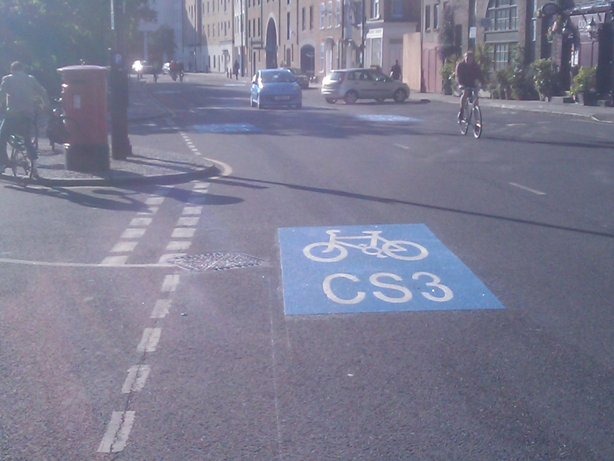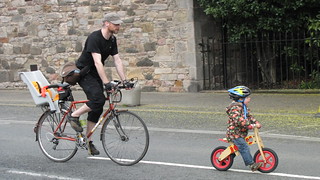@ The Radgeworks @ allebong
Thank you both for your comments.
I thought I would begin my response by telling you about Darlington (if you don't mind).
Darlington has the unique distinction of having been (concurrently) both a Sustainable Travel Demonstration Town and a Cycling Demonstration Town. The Guardian suggested in an article from 2006 that Darlington is "the crucible of a grand experiment".
"What we would like to get out of the Cycle Demonstration Town project," Phillip Darnton from Cycling England explained, "is the clearest possible indication that investing at European levels will make a real difference to the number of trips people make by bike."
There was a lot riding on it, The Guardian article noted. "If we're wrong," Darnton said, "we've blown it completely."
With regards to the cycle network, the emphasis was on developing the quietest — not the most direct — routes to destinations. Indeed, as the local cycle campaign group noted in 2007: "A potpourri of recorded cycling situations in Darlington shows a town that is trying to build a series of cycle routes, some comfortable at times, some provisional, most never quite getting from A to B in any meaningful sense."
[I am reminded here of the proposed cycle network for Manchester.]
The local authority had set relatively modest targets, hoping to increase the number of people cycling by 200% (that is, to raise the modal share of cycling from 1% to 3%). However, according to the BBC, the increase was just 27% (that is to say, a shortfall of 173%). Even so, Cycling England hailed the project "a success".
I think that if the UK is to develop a successful cycling culture, it is important that we profit from such "experiments", not by pretending something which isn't, but by trying again in a different way.
The case is, a 'Network first' approach has never before been tried in the UK, despite some very strong evidence that it would be the most effective way forward.
@ allebong
I've also felt the words 'Quality Bike Corridor' hanging over this thread.
But as Ricardo Marques Sillero (from A Contramano, Seville's cycling group) has pointed out: "Isolated cycle paths are almost useless if they’re not connected."
Besides, the best time to develop 'Quality Bike Corridors' is when the road is resurfaced.
If it is not possible to systematically remodel the entire network to better meet the needs of cyclists [all in one go], specific action can be taken on each occasion that works need to be done. Most of the time, the additional expenditure needed to meet the requirements of cyclists is comparatively minimal.
Page 56, Cycling: the way ahead
In a great many situations, the small excesses of expenditure for cycling will be reduced even further if thought is given to cyclists already at the stage when changes to the roadway are planned. Costly installations are rare (these are, above all, cycle tracks and special traffic lights).
Page 45, Cycling: the way ahead
My impression is that doing Step 4 ought not to be too difficult, but doing Step 5 is going to be a challenge. That's what I think, anyway. But then again, I also think that you've got to take the long view. For example, forty-one years after they started, the Dutch are still working at it.
Regarding the debate about whether or not cycling is dangerous, Ashok Sinha was asked by the Transport Select Committee if he would say it's safe to cycle in London:
In general, yes. I would still say to people that with care and attention it is a safe way of getting about. But I think my answer would need to be nuanced. I think there are places in London at times in London where you are not protected as well as you should be as a cyclist, and you will face real risks, such as at major junctions. I advise people that it is safe to cycle in London, but at the same time, I am very wary about my children cycling in London, because I know that a mistake that can easily be made by a young person could lead to their death and serious injury.
So my answer has to be nuanced. I would say to people, "Yes, keep cycling, it is a safe way of getting around; but there are dangers in particular places and particular circumstances.
My view is that cycling would be made safer if there were regular physical cues available to people — what Doug Gordon (author of the website Brooklyn Spoke) calls "clarity of design".
As he explains, when you're cycling down a street, you don't always have very long to make complicated decisions. "You just want those choices to be made very, very clear for you."

Image from London Cyclist
I am no Franklinite; and I know that these markers do nothing to address issues such as dooring, and do little to make cycling subjectively safer (for the Interested but Concerned, I mean). But in my opinion, for as long as a vehicular cycling environment persists, these are a reasonably okay solution (at least in the short-term, at least until something better can be installed).
Anyway, love them or hate them, this is how things are going to be in London. (Well, it's either these or nothing, and I know which I would prefer.)
Stressing that I am talking here about short-term solutions, another measure — which is linked to a different aspect of good cycle provision — is to make alternative cycle routes more numerous, more comfortable, easier to follow, and more convenient (by removing annoyances for cyclists, for example).
I don't think anyone here would object if this network was to materialise magically overnight.
Saying this ... "I don't believe politicians would have any problems at all with it if the cycling lobby found it agreeable. The ball is in our court" ... comes across at best as lazy.
I surrender.


 posts
posts
